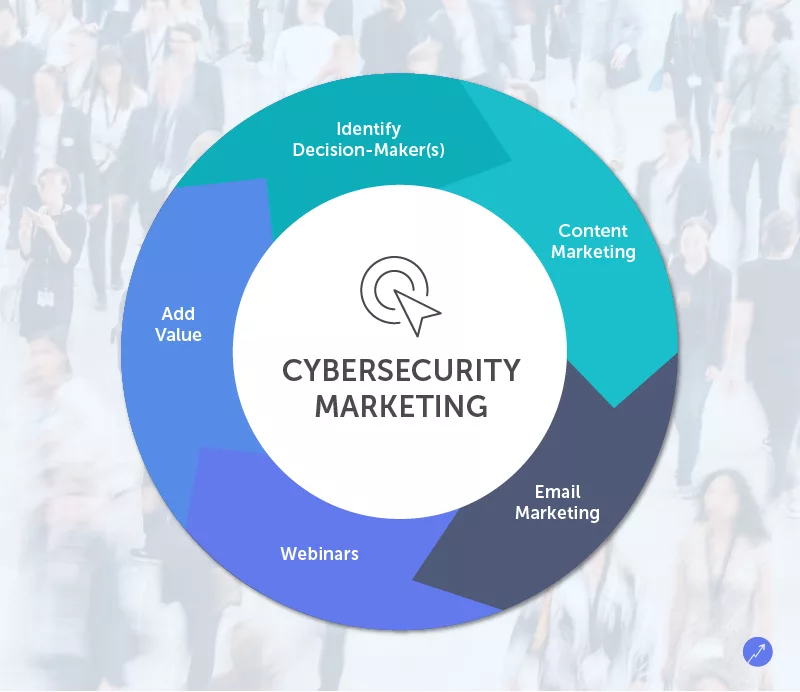Whether you want to attribute it to the rise in the IoT revolution of interconnected devices or just the rising instances of cybercrime, the information security industry has seen enormous growth in recent years and shows no signs of stopping.
Moreover, according to a Cybersecurity Market Report published by Cybersecurity Ventures, spending on cybersecurity products and services worldwide is expected to reach $1 trillion by 2021. This spending will come as no surprise because, according to the Ponemon Institute, the estimated annual cost of cyber-attacks worldwide is about $9.5 million.
Having worked with cybersecurity clients, we understand that standing out in the crowd and communicating your brand’s value can be a challenge. In the age of sales intelligence and data-driven marketing, we have identified several strategies over the last few years that work well for cybersecurity companies and increase sales.
Below we will address why cybersecurity marketing can be such a challenge and how cybersecurity organizations can use marketing strategies to increase their reach and conversions.
Cybersecurity Marketing Challenges
Before we get into cybersecurity marketing tactics, let’s look at the challenges that marketers in this industry often face. Here are just a few of the roadblocks you may experience while trying to reach your target audience.
1. Competition:
In response to growing demand, new cybersecurity firms are popping up all the time. The rising competition can make it difficult to stand out in the crowd, and it makes it crucial for you to communicate your brand differentiators. Though it is necessary to stand out from your competitors, you also want to be credible.
2. Threat Awareness Amongst Potential Customers
There are many different cyber threats out there, and those threats can change every day. As a result, you need to educate your potential customers to make them aware of the risks they face and what solutions they may need.
3. Businesses Not Prioritizing Cybersecurity.
The United States ranks highest with 18.2% of all ransomware attacks. 68% of business leaders feel their cybersecurity risks are increasing. While there is plenty of evidence pointing to the need for cybersecurity to secure valuable data, the fact is that many companies don’t feel the need to prioritize cybersecurity until it’s too late.
Cybersecurity Marketing Tactics
Let’s face it, some businesses don’t see cybersecurity as an investment. Instead, they see it as a cost to the company.
Keeping that in mind, to improve revenue growth, profitability, and cybersecurity customer loyalty, here is a five-point strategy for more efficient cybersecurity marketing.

1. Identify the Decision-Maker(s)
Before you start approaching your accounts, it’s also necessary to identify and understand your decision-maker. While CTOs are easy targets, these aren’t the only people who are interested in your solutions. High-ranking IT professionals will likely have a say in which cybersecurity solution a company decides to go with.
However, given the essential nature of data security, the CEO will always be the ultimate decision-maker, and the decision-making process may include other C-level executives too.
If you are selling to the CEO or the CTO, certain aspects stay the same – you need to be honest about the strengths of your solution and take a data-driven approach to your communication.
Use a sales intelligence tool to access B2B data and details about the decision-maker as well as the technographic and firmographic data you need to target the right accounts. This will save the time you would have invested otherwise in identifying priority targets.
2. Content (Context) Marketing
Content marketing that focuses on the buyers’ interest is known as context marketing. Context marketing will help you develop credibility while answering your prospects’ primary challenges. It’s essential that you include real-world examples that illustrate both the value of cybersecurity and the efficacy of your solutions to make your content successful.
Not only does the content need to be detailed and data-driven, but you will want to make sure it’s unique as well. Create educational content that clearly illustrates how your services can solve a real-life cybersecurity attack. Use case studies and industry reviews as support.
3. Email Marketing
Since knowledge and awareness is an obstacle to selling cybersecurity solutions, it can sometimes take a considerable amount of time for a potential lead to reach the point where they are prepared to request a demo or contact a sales representative. Meanwhile, you should find a way to cultivate those leads and push them down the funnel. Email marketing is an easy and cost-effective way of doing just that.
With too many emails in your prospects’ inbox, if they don’t find your content worthwhile, they might be inclined to delete your email or unsubscribe. Here are some examples of content for your email marketing that you could include:
- Downloadable content such as e-books, case studies, and reports provide readers with a more in-depth understanding of essential cybersecurity issues.
- Links to your current blog posts covering recent attacks or security issues and those that break down complex information security subjects for a broader audience to learn.
- A video that underlines the importance of cybersecurity and demonstrates the value of the service you will provide.
- Monthly offers and sales promotions like a free trial, can encourage prospects to sign up.
Generic cold email sales pitch email blasts are dead. Make sure that you are personalizing your email messaging. You can use firmographic and technographic B2B data to personalize your messaging for better engagement.
4. Webinars
Webinars are a great way to link cybersecurity marketers with bottom-of-the-funnel leads. Webinar participants are already interested in learning more about your solution, the risks it protects against, and usually, they have taken some time to do research. That means they are more likely to be interested in the topics that you are addressing.
Webinars open up valuable opportunities to share other helpful content or encourage demo sign-ups.
5. Add Value to Every Interaction
Whenever you meet with a client or send them an email, ask yourself what your goal is. Most of us-whether on the buying side or on the selling side-get inundated every minute with pitches. We need to sift through this flood of information to decide which conversations are worth spending more time on and which ones should be discarded. So make sure your outreach provides value to your prospect and you will find interest, engagement and ultimately conversions will increase.
Conclusion
This five-point approach will solidify your cybersecurity marketing. Now it is up to you to know your target market and apply this strategy to the most appropriate tactics for your Cyber Security business.




